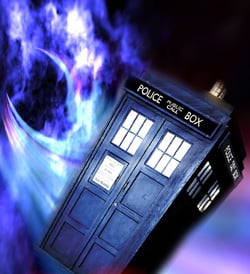 Time travel is one of those things that seems so simple until you think about it too much and then your brain just hurts. It isn’t so much the mechanics of traveling in time. It doesn’t really matter if you prefer to travel in a DeLorean, a phone booth, a TARDIS, or a starship slingshot around the sun. In a pinch you can even use an enchanted pocket watch or even the occasional hot tub. After all, while Einstein’s relativity predicts it should be possible, his equations didn’t specify the type of vehicle required. Yet it’s the mind bending implications of what happens once you do start hopping about on the timeline that are really interesting.
Time travel is one of those things that seems so simple until you think about it too much and then your brain just hurts. It isn’t so much the mechanics of traveling in time. It doesn’t really matter if you prefer to travel in a DeLorean, a phone booth, a TARDIS, or a starship slingshot around the sun. In a pinch you can even use an enchanted pocket watch or even the occasional hot tub. After all, while Einstein’s relativity predicts it should be possible, his equations didn’t specify the type of vehicle required. Yet it’s the mind bending implications of what happens once you do start hopping about on the timeline that are really interesting.
The implications of being able to travel in time depend entirely on the assumptions you make about how time is woven together. And this is something humans currently don’t understand, which gives you a lot of latitude to be ridiculously creative. This is maybe why it is a frequent dinner table topic at my house.
Most often in fiction, time is seen as a dependent tapestry of sorts. If you go back and make changes, then your future is disrupted. The most obvious problem here being the famed “grandfather paradox.” Suppose you went back in time and killed your grandfather before your father was ever born. Then you would not have been born. So you couldn’t have gone back in time to kill your grandfather. So he’s still alive, and you are born… except that you killed him.
There are other silly implications of the tapestry model which Bill & Ted’s Excellent Adventure had great fun with, and Dr. Who inexplicably adopted for their most recent season finale. Assuming you have access to a time machine, you can effect instantaneous changes to the present by simply deciding that at some point in the future you’ll go back into the past and effect the change. Suppose you find yourself locked out of your house. You could decide that later today you’ll pop back to yesterday and hide the spare key under the plant on the porch. Voila! The key is now there when previously it wasn’t. So basically, as soon as you get your hands on a flux capacitor, you can perform magic. Cooler yet, you will have always been able to perform magic. And since you can’t, it means you never will. Another dream shot to hell.
To get around this, some physicists have proposed a quantum model of time. Essentially it posits that time is not linear, but rather branches out at each instance to allow for all possible outcomes. So when you go back and make a change, it’s not really a change since both the reality with the change and without the change co-exist. Aside from the brain cramp induced by trying to conceive of a tree with infinite branches each in turn having infinite child branches and so on out until infinity, this creates the WTF paradox. In essence, any time you are confronted with a decision, it doesn’t matter what you do because the mere existence of the decision point means you made all available choices in one of the parallel universes. So why sweat the choice? I mean, WTF? Is your grandpa alive or dead? Well, yes.
Along comes Seth Lloyd at MIT who has another model for all this timey-wimey stuff. Since quantum outcomes are all probabilistic, Lloyd’s theory is that probabilities are altered to prevent paradoxes. That is, the universe actually enforces rules against time travel paradoxes by making paradox inducing actions improbable. This is all predicated on the existence of “closed timelike curves”. These structures are information pathways across space-time that link paradoxical events. In essence, should you try and go back and kill your grandfather, the chances of the bullet being a dud or the gun misfiring become a statistical certainty. Basically, the universe will simply not allow you to ruin your grandmother’s day.
Einstein’s equations allow for these closed timelike curves, and Lloyd’s team has even done some experiments with photons demonstrating that quantum statistics are demonstrably altered when paradoxical possibilities are introduced. This is a far cry from proof about how time works, but it is one of the more promising steps I’ve seen, and so far it makes my brain hurt less than the other possibilities. And understanding the nature of time is somewhat of a prerequisite to doing a time-ship conversion on an old British police box.
Pass the salad please?
